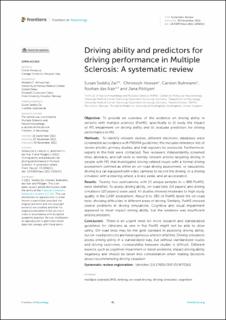| dc.contributor.author | Seddiq Zai, Susan | |
| dc.contributor.author | Heesen, Christoph | |
| dc.contributor.author | Buhmann, Carsten | |
| dc.contributor.author | das Nair, Roshan | |
| dc.contributor.author | Pöttgen, Jana | |
| dc.date.accessioned | 2023-02-22T15:18:51Z | |
| dc.date.available | 2023-02-22T15:18:51Z | |
| dc.date.created | 2023-01-04T10:16:47Z | |
| dc.date.issued | 2022 | |
| dc.identifier.citation | Frontiers in Neurology. 2022, 13, 1056411. | en_US |
| dc.identifier.issn | 1664-2295 | |
| dc.identifier.uri | https://hdl.handle.net/11250/3053404 | |
| dc.description.abstract | Objective:
To provide an overview of the evidence on driving ability in persons with multiple sclerosis (PwMS), specifically to (i) study the impact of MS impairment on driving ability and (ii) evaluate predictors for driving performance in MS.
Methods:
To identify relevant studies, different electronic databases were screened in accordance with PRISMA guidelines; this includes reference lists of review articles, primary studies, and trial registers for protocols. Furthermore, experts in the field were contacted. Two reviewers independently screened titles, abstracts, and full-texts to identify relevant articles targeting driving in people with MS that investigated driving-related issues with a formal driving assessment (defined as either an on-road driving assessment; or naturalistic driving in a car equipped with video cameras to record the driving; or a driving simulator with a steering wheel, a brake pedal, and an accelerator).
Results:
Twenty-four publications, with 15 unique samples (n = 806 PwMS), were identified. To assess driving ability, on-road tests (14 papers) and driving simulators (10 papers) were used. All studies showed moderate to high study quality in the CASP assessment. About 6 to 38% of PwMS failed the on-road tests, showing difficulties in different areas of driving. Similarly, PwMS showed several problems in driving simulations. Cognitive and visual impairment appeared to most impact driving ability, but the evidence was insufficient and inconsistent.
Conclusion:
There is an urgent need for more research and standardized guidelines for clinicians as one in five PwMS might not be able to drive safely. On-road tests may be the gold standard in assessing driving ability, but on-road protocols are heterogeneous and not infallible. Driving simulators assess driving ability in a standardized way, but without standardized routes and driving outcomes, comparability between studies is difficult. Different aspects, such as cognitive impairment or vision problems, impact driving ability negatively and should be taken into consideration when making decisions about recommending driving cessation. | en_US |
| dc.language.iso | eng | en_US |
| dc.publisher | Frontiers | en_US |
| dc.rights | Navngivelse 4.0 Internasjonal | * |
| dc.rights.uri | http://creativecommons.org/licenses/by/4.0/deed.no | * |
| dc.title | Driving ability and predictors for driving performance in Multiple Sclerosis: A systematic review | en_US |
| dc.title.alternative | Driving ability and predictors for driving performance in Multiple Sclerosis: A systematic review | en_US |
| dc.type | Peer reviewed | en_US |
| dc.type | Journal article | en_US |
| dc.description.version | publishedVersion | en_US |
| dc.rights.holder | © 2022 Seddiq Zai, Heesen, Buhmann, das Nair and Pöttgen | en_US |
| dc.source.volume | 13 | en_US |
| dc.source.journal | Frontiers in Neurology | en_US |
| dc.identifier.doi | 10.3389/fneur.2022.1056411 | |
| dc.identifier.cristin | 2100249 | |
| dc.source.articlenumber | 1056411 | en_US |
| cristin.ispublished | true | |
| cristin.fulltext | original | |
| cristin.qualitycode | 1 | |

